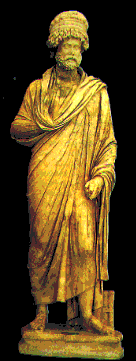
The sun warms the civilizations and shines upon Aphrodisias over Baba Mount. The mount blesses fertility with the melted snow rushing down from its 2308m. high peaks to the plain situated on the western side, as it has been doing since centuries. And the village of Geyre, 13 km to Aydin, Karasu, from the Eastern direction, has been hand in hand with olive, walnut, ponogranate trees and emerald green orchards for centruies. The place is a plateau 600 meters high from he sea level. Dandalaz brook run s along the southern borders of the plateau, then turns to west and finally reaches mhytical Menderes river 25 km. down. Menderes running delicately through the valley of civilizations, becomes breathless around Karine and carries Aphrodithe's salut e to the Mediterranean.
Aphrodisias is the city of Goddess of love; Aphrodithe. She comes from the depths of the ancient times, and meets us for the first time in Neolithic era, as the caring mother goddess.
The first settlements on this furtile land appear 7800 years ago, in late neolithic and calcolithic eras. They continue during bronze and the following ages.
The answer to how this Mother-Goddess cult came here goes back to the home of Israel sons: Sidon. The goddess of love came to be known as Astartia in Sidon and as Istar in Babylon and Ninova. According to Byzantine historian Stephanus the first name of Aphrodisias was Lelegonpolis. Later it was called Megapolis and following the reign of Assyrian King Ninos, Ninoi. After the destruction of their city by Meds and Babylons, Assyrians bring their Istar cult to this intact site. Depictions of Nino s and his wife Semiramis' profiles scraped on a relief, which came into light during excavations, prove this view.
We get the first source of information about Aphrodisias from Aphrodisian historian Apollonios who wrote a book on Karia region. In the year 2 BC Aphrodisias had established an alliance with its neighbouring city of Plarasa to mint money. In 82 BC, Roman general Sulla presents a golden crown and a holy double-bladed axe to the temple of Aphrodithe. This act is a proof of t he increased importance gained by the city due to Roman sovereignity.
During the Roman emperorship period which starts with Augustus, Aphrodisias became a rich, well known and important city. In Byzantine period Christianity could not succeed to invade the city at a short time, consequently paganism associated with A phrodithe's personality continued to exist. However at the end of the paganism and Christianity duality, Christians had ruled the city and changed its name into Stauropolis. This event caused all the matchless sculptures to be ruined and destroyed. In July, 1969 the arrival of a young Turkish archeologist had changed the fate of Aphrodisias and also his own. This young man, who had dedicated himself to Aphrodisias, was Kenan Erim. Prof.Dr. Kenan Erim had staned the scientific excavations in 1961 and had lived with it until he died in Nov 3,1990. Everything we see in Aphrodisias today is his traces. Now let's visit all around the site.